II.
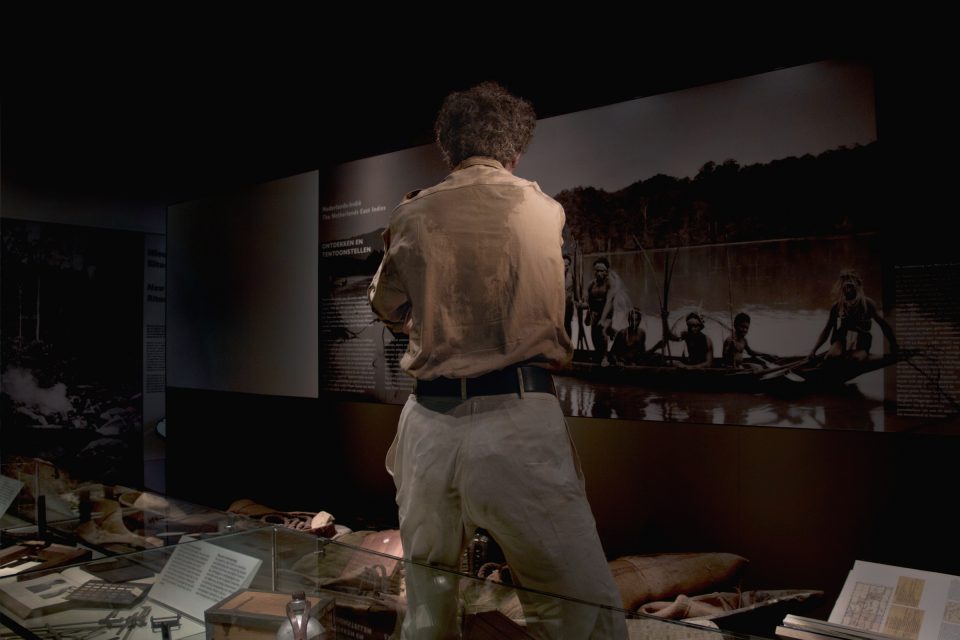 Solar: A Meltdown (2014–17), lecture and video installation with digital print, solar-powered toy and punka (colonial fan). Photo Ho Rui An. All images: Unless otherwise noted, courtesy Ho Rui An.
Solar: A Meltdown (2014–17), lecture and video installation with digital print, solar-powered toy and punka (colonial fan). Photo Ho Rui An. All images: Unless otherwise noted, courtesy Ho Rui An.
ART iT: We were just discussing the contradictory or entangled relations between racialized discourses of universalization and particularization. To what extent can one as an individual transcend that entanglement? For example, in your lectures you bring together all kinds of information, analysis, and videos sourced from YouTube and Hollywood, which gives the sense that you are taking a global perspective. How does your coming from Singapore inform your thinking?
HRA: The funny thing about Singapore—and this is also why the lecture doesn’t focus so much on Singapore itself—is that it is such an exception to the region, even when it comes to the so-called East Asian miracle. For one, many of the economies in the region cannot afford to be as liberalized as Singapore. Of course, a lot of this has to do with the peculiar geopolitical condition of a sovereign city-state, which imposes particular parameters for governance and capital accumulation. As we know, Singapore grew incredibly wealthy through free trade and financialization. It’s the reason why a country with so few natural resources apart from its strategic location along the Strait of Malacca became so affluent within such a short time. Despite the current antiglobalization movements sweeping across the world, and despite Singapore experiencing some of the discontents of globalization itself, almost every Singaporean would recognize that the country has been a beneficiary of globalization. It’s true that, as in other parts of the world, many Singaporeans are also facing widening economic inequality, the rise of the superrich class, and everything else that accompanies neoliberalization, but at the same time there is an utter lack of imagination or even a fear to imagine what an alternative economic system might look like. Singapore today has never felt more like an island.
But I think once you reckon with the exceptionality of Singapore, you are compelled to understand the nonexceptional as well. We are told something works in so many other places—say, instituting a minimum wage—but not in Singapore because of our particular circumstances. And at some point you start to see how this discourse of exceptionality has been operationalized to foreclose what is politically possible. This operationalization of the exception is in itself not exceptional, but in fact rather exemplary of how state power operates in many parts of the world.
ART iT: Let’s change tack here to address the format of the lecture performance, which seems to have emerged out of your earlier video-based projects. What brought you to this format?
HRA: The first medium that I was deeply engaged with as an artist was film, and I still make videos and work in a moving image context. The move into the lecture as a performance medium came about because I was interested in exploding the form of film toward a kind of paracinema.
One form that fascinated me when I was researching cinema history is the cinematic lecture. This is the form in which most films were presented in the early days of cinema, where cinema meant a semitheatrical experience involving a live body. There was almost always a live body either introducing the film or even directly participating in the narrative itself. In Japan, there was the benshi narrator. In Thailand, there were the versionists who would travel in troupes in the provinces, where they would present films accompanied by a live aural performance that served to supplement the projected image in various ways, from narration to dubbing, commentary or even critique. I thank the Thai film historian May Adadol Ingawanij for introducing this history to me. She shared that sometimes the versionist would even replace the names of the characters with the names of villagers. Given that many of these films were made in Hollywood or India, you can read this practice as an extreme localization of the foreign or generic. In engaging with this history, I was fascinated by the positionality of the live body beside the screen, sometimes speaking about the film being projected, sometimes speaking inside of it by voicing the characters, sometimes speaking around it, or sometimes speaking back to it.
It was very refreshing for me to see how the apparatus of cinema changes in these different contexts, because if you were to go to the cinema today, you would have the impression that the apparatus hasn’t really changed since the 1930s. Even with 3D today, it’s still pretty much a single-screen experience. The unicity of the experience continues to be valorized despite all the other innovations that have happened within the parameters of the screen itself. Compare this to contemporary art, where the material form of the artwork has completely exploded. I think one reason is that some of these more vernacular understandings of cinema that took the medium beyond the single screen were so deformalized that even the people who were effectively bringing the film to life were not seen as artists or innovators in their time. They thus remain paracinematic in relation to what is held up to be “cinema proper.”
ART iT: So figures such as the benshi provided you a way into the lecture format?
HRA: The benshi is an interesting example to think about. What does it mean to speak of cinema outside of the screen? Listening to a live body that is physically present outside the screen is different from listening to the voiceover narration of an essay film—even though the essay film is a key reference for me.
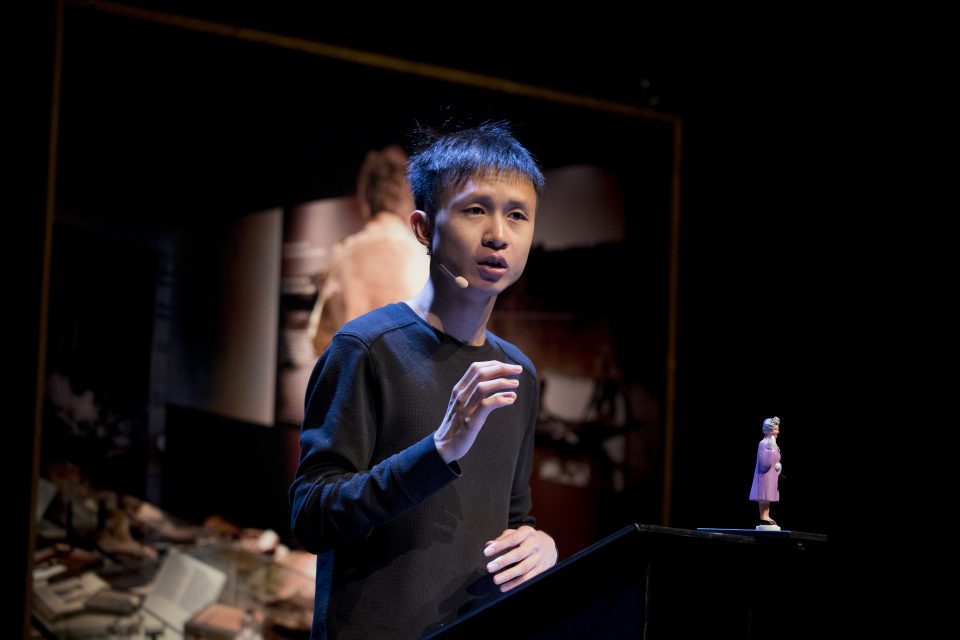
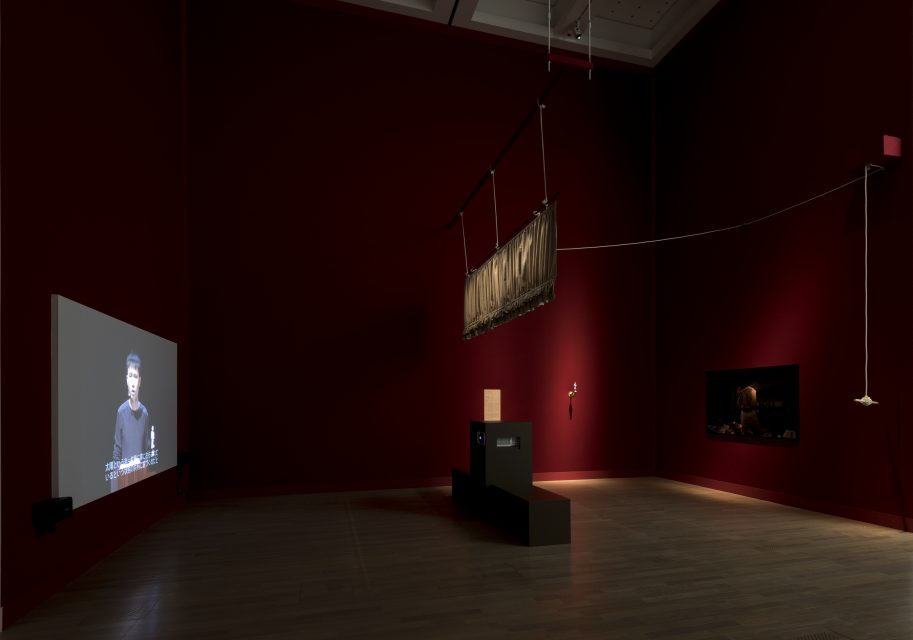
Above: Solar: A Meltdown, performance view. Photo Eike Walkenhorst. Below: Installation view in “Sunshower: Contemporary Art from Southeast Asia 1980s to Now” at the National Art Center, Tokyo, 2017. Photo Norihiro Ueno.
ART iT: Yet the combination of live speaking and projected images in your lecture performances also recalls voiceover narration.
HRA: Yes, and I’ve shown the lectures as videos as well, so in the end it’s remediated by cinema. But I also see an interesting dialogue developing between cinema and live performance today. These days we tend to see lectures more often through YouTube or other video streaming platforms.
ART iT: The TED talk has become synonymous with edutainment in the popular consciousness.
HRA: I try to avoid being compared to that. I find that TED has monopolized the lecture, or what we understand to be a lecture. But what’s most interesting for me is how the TED talk today is primarily experienced as a video. The people who get a seat in the audience are often very privileged. When you watch the video, you already have the sense of not being there, of not having live access to a site of originality.
ART iT: How do you relate to your audience?
HRA: It really depends on the subject of the lecture and the specific cultural and social contexts I’m engaging with. For each lecture I tend to think of a spatial metaphor to understand the space of the performance. With Solar: A Meltdown (2014-17), which looks at the historical turn between the colonial and global eras, I was thinking about how one can appropriate the form of the colonial lecture or lecture tour. The colonial lecture is also a paracinematic form in that the anthropologist travels to the colonies to collect images to be brought back to the metropole, where the lecture then becomes the form by which to present these images—which are exotic, foreign, and require a live narrator to explain them.
With DASH (2016- ), I was working from the positionality of sitting behind the dashboard of a vehicle. This accounts for the very specific way I install the work when it is manifested as a video installation. The viewer sits in a modified car seat, and I speak to them directly through a tablet attached to the arm of the seat. It’s the only lecture of mine where the documentation as seen in the video installation does not show me speaking to a live audience. The mode of address is hyperindividualized, with the viewers experiencing the work through their own personal screens. I was also thinking about the car itself as a cinematic apparatus or, specifically, the windshield as a frame through which to look at the road. I’ve encountered taxis in Thailand where you get in and find the whole dashboard filled with all kinds of media technologies, from dashcams to tablets to Buddhist amulets. So within the cinematic apparatus of the car itself you have all these other apparatuses making up a whole new optical-motor complex.
Asia the Unmiraculous, on the other hand, is a bit of a magic show. Things appear and disappear, in the same way that the value of an entire economy can vanish overnight. As an installation, the work resembles a waiting room, or a space where you wait for a miracle that may or may not arrive.
ART iT: In Screen Green (2015-16) you posit that citizens participate in politics by projecting their imagination onto the nation. How do viewers participate in the lecture format?
HRA: They listen? I mean, sure, the form is not one in which there is direct audience participation, but I don’t think that is a problem in itself. I personally do really enjoy listening to lectures where you can follow the flow of an argument and feel the buildup and release of tension as concepts are being stretched and tested. That said, this does not mean the research for the work takes place in an enclosed and nonparticipatory setting. For Asia the Unmiraculous, in particular, a lot of the material in the lecture came out of a series of workshops I organized in Bangkok between 2017 and 2018. Some of the sessions involved reading and discussing texts, while others were more open-ended in that I would workshop certain ideas in relation to texts we had read and also have the participants bring their experiences to the table. A lot of the anecdotes that became part of the lecture came out of that process. Given the transnational scope of the research, the workshop was a very important form through which I engaged with the specific conditions of each locality.
ART iT: Where else did you hold workshops?
HRA: I was only able to do an entire workshop series in Bangkok, as I had the opportunity to spend more time there through a residency with Tentacles Art Space. In other places where I couldn’t spend as much time, I was able to do presentations of my research, sometimes through a work-in-progress performance, followed by a dialogue or discussion. These included presentations in Seoul, Athens, Yinchuan, Paris and Taipei.
I enjoy having discussions in a smaller and more focused setting, as opposed to them happening in a post-show dialogue in a theater. The theater can be an overwhelming space. It certainly has affordances that can reshape our experience of the performance, but what I enjoy about working in the lecture form is the flexibility of scaling the performance up or down to adapt to the conditions of the space. The minimum that I need is a projector and a lectern. This flexibility is also what gives the form its portability. It’s relatively easy to travel the work and insert it into a variety of spaces.
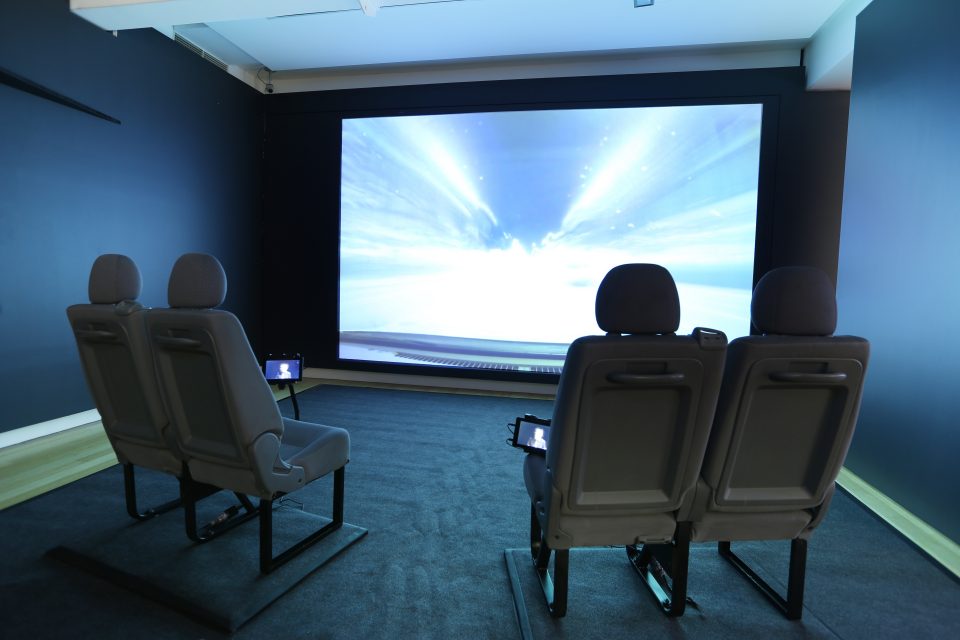
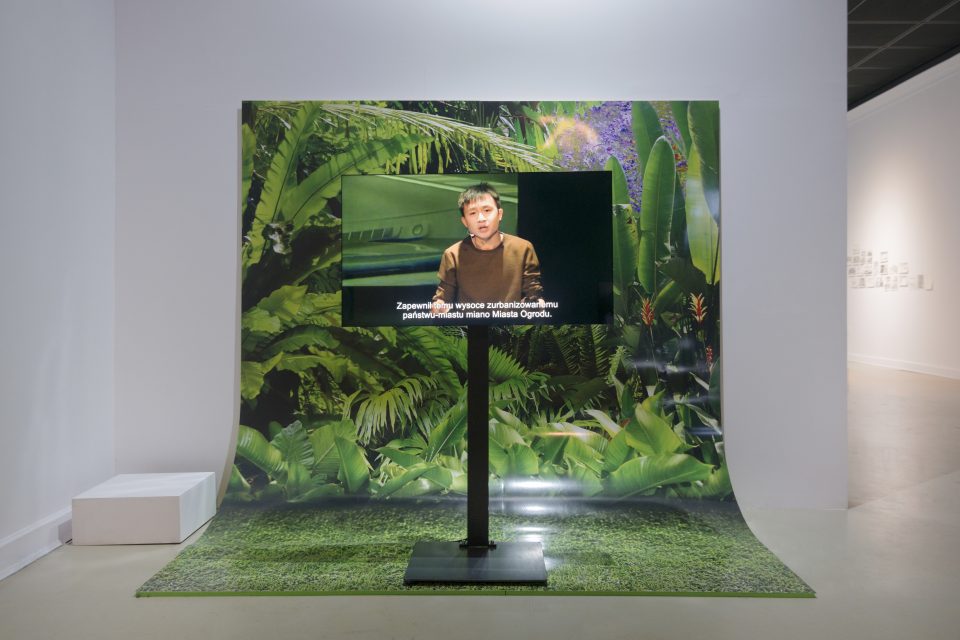
Above: DASH (2016–18), lecture and video installation with car seats and synchronized screens. Photo Sam Cranstoun. Below: Screen Green (2015–16), lecture and video installation with green screen. Photo Bartosz Górka.
ART iT: How do you conceive the audience as an addressee? Your presenting Asia the Unmiraculous in places like Taiwan or Yamaguchi suggests that you are addressing an Asian audience, but then again the work’s critique of the racialization of finance also seems directed at a notional Western audience.
HRA: Asia the Unmiraculous was commissioned for the Gwangju Biennale and for “The Breathing of Maps” at Yamaguchi Center for Arts and Media, so I did make the work assuming that the audience would have a degree of familiarity with the material and the context in East and Southeast Asia. I think this is important, because so often I find that even for works produced in Asia and for an audience in Asia, there is a pressure to speak to a notional “international” audience, which, as you’ve suggested, is more often than not imagined to be at least partly European. It’s hard to escape from that perception, as often the mere presence of a European in the audience suggests “internationality.” One of my aspirations for this work is thus for it to open up conversations between countries in the geographical region we identify as Asia. That’s why a good part of the narrative concerns how these countries were looking or not looking at each other during the economic miracle and the crisis that followed, and their different approaches to liberalization. But to do this I have to assume that my audience can at the very least identify these countries on a map. The work cannot be an introductory course on Southeast Asia. Contemporary art from Southeast Asia has been circulating internationally for a good 30 years now, and at some point you would think that the conversations would have broadened by now. Besides, as an audience member I personally like being thrown things that are completely foreign or even alienating to me, because then I know I’m learning something.
I | II | III
Ho Rui An: Image Crisis
